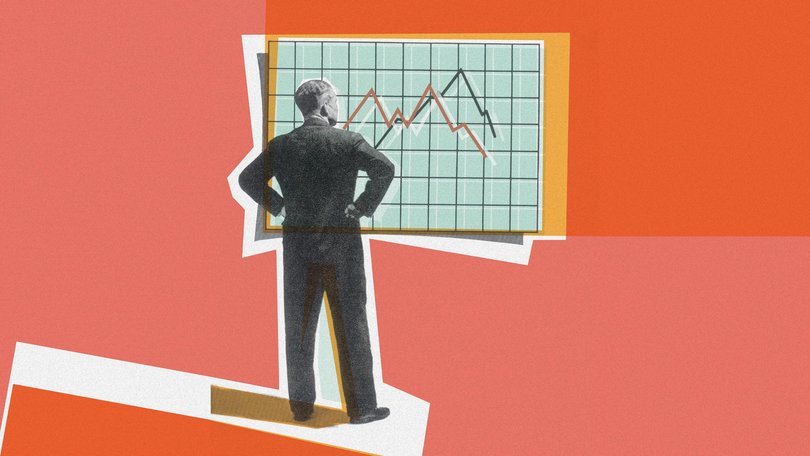Australian economy: How the investment drought keeps nation’s GDP in the slow lane

What will it take to get Australia out of the post-COVID mire?
It’s a critically important question if the country is to get off the drug of Government spending to prop up the economy and start generating sustainable growth.
The latest GDP figures reveal that with Government spending coming off, the country has drifted back into toward a per capita recesssion.
Sign up to The Nightly's newsletters.
Get the first look at the digital newspaper, curated daily stories and breaking headlines delivered to your inbox.
By continuing you agree to our Terms and Privacy Policy.Australia’s economy grew just 0.2 per cent in the first three months of the year, meaning the country is just limping along at 1.3 per cent growth for the year, down from 1.6 per cent compared to the December quarter.
The biggest drag on the economy was the drop-off in public spending, including a reduction in subsidies for energy rebates. A number of State infrastructure projects either wound up or were delayed. Cyclone Alfred and record flooding in Queensland also hit growth.
Treasurer Jim Chalmers, acknowledged the worse than forecast result, but said any growth was “welcome” given the current global turmoil.
“When you look at these numbers today, no major advanced economy has our combination of unemployment in the low fours, inflation below two and a half percent, and three years of continuous growth,” Dr Chalmers said.
“That 0.2 per cent in the quarter, the 1.3 per cent through the year should be seen in the context (that) most of our peers in the OECD have had negative quarters.”
The Treasurer knows that he has to wean the economy off Government spending, not just to slow the growth in deficits, but to encourage business to take up the slack.
One of the common refrains from industry groups is that Government spending “crowds out” business investment and economic reform is needed to unleash that confidence.
Dr Chalmers admitted that the economy needed transformation, noting the 1.7 per cent fall in business investment in machinery and equipment over the quarter.
Along with that drop in invesment in new machinery and equipment, labour productivity also sagged. According to veteran economist Saul Eslake, GDP per hour worked has fallen by 5.3 per cent over the past three years, and is only 0.3 per cent higher than it was seven years ago.
EY’s chief economist Cherelle Murphy was one of many economists sounding the alarm.
“It is a warning sign that changed policy conditions are needed to boost the economy’s capacity and ability to cope with new challenges,” she said.
Australian Industry Group chief executive Innes Willox called the collapse in business investment a ‘canary in the coal mine’.
“With the economy at a low ebb, regulatory settings in flux and global markets in turmoil, businesses do not have sufficient confidence to make long the long-term investments needed for productivity growth.”
Dr Chalmers has put productivity at the top of the second-term agenda, commissioning the Productivity Commission to come up with five areas for transformation, including the energy transition, a skilled workforce and the digital economy.
He has also put economist and assistant treasurer Andrew Leigh on the case, who is trying to see if the ideas in a book called Abundance by a couple of left-wing US journalists can be applied to Australia.
Business says productivity will only go up if governments cut red tape and give bigger tax breaks for capital investment.
But according to Mr Eslake, there is little evidence of productivity improvements under those conditions.
That is the case globally, including much of the US which is held up as the poster child of productivity.
Mr Eslake said there has been a dearth in spending since before COVID, with businesses preferring to hire and fire workers, rather than commit to big spending on machines.
“If a business makes a bad capital decision, they’ll cop it from the share market and the CEO won’t make a bonus. Plus the share market tends to applaud when workers get the sack,” he said.
That view is shared by Deloitte Australia partner Stephen Smith.
“Weak business investment growth has been a long running issue for Australia, and for most other developed economies. There are a number of contributing factors, including a widely-held focus on short-term business performance over long-term thinking,” Mr Smith said.
Also slowing productivity; low turnover in the workforce as a result of labour non-compete clauses and the rise of so-called ‘Zombie’ firms hanging on in unproductive enterprises thanks to lower interest rates and COVID-related tax breaks.
One area that may be an easy fix is unwinding some of the post-GFC rules around how much capital banks can hold. In a bid to protect another system wide crisis, banks have been effectively cut off from making riskier bets.
That has effectively constrained them to lending primarily to households. Good for bank balance sheets, bad for a dynamic economy.
Mr Eslake is also not convinced by business lobbyists arguments that more tax breaks results in greater investment.
“Their answer is almost always is ‘let’s cut company tax’. Going back to the Turnbull tax cuts for businesses with turnover under $50m lifted business investment,” he said.
That is also the case in the US as well, with Trump tax cuts overwhelmingly leading to share buybacks, lining investors’ pockets, rather than boosting business investment.
“If we cut the company tax rate in Australia, the biggest beneficiaries will be offshore investors, because local shareholders would have to make up for that loss of revenue via their franking credits,” he said.
A slow grind
With Government spending coming off, and global turmoil crimping investment, it might be up to the consumer to get the economy firing.
AMP’s Diana Mousina estimates households are better off to the tune of $108 per week compared to a year ago as a result of tax and interest rate cuts.
They are slowly building up their savings balances but more rate cuts are needed if the economy is to get further off the canvas.
“Our view is that domestic conditions are going to slowly improve in the next 12-18 months but, in the environment of uncertain global trade policy and heightened consumer and business concern, it’s hard to see a fast turnaround in GDP growth,” Ms Mousina said.
Based on the weak quarterly data, AMP now expects another interest rate cut in July for a total of four more cuts bringing the rate down to 2.85 per cent.
Coming out of COVID is proving harder than almost every country expected but Ms Mousina shares the Treasurer’s glass-half-full optimism.
“A very long-term chart of per capita GDP, shows that since 1900 Australia has actually done very well, relative to our global peers,” she said.
“But, productivity growth needs to lift in Australia if we are to maintain our track record.”
Expect to hear that word for years to come.

